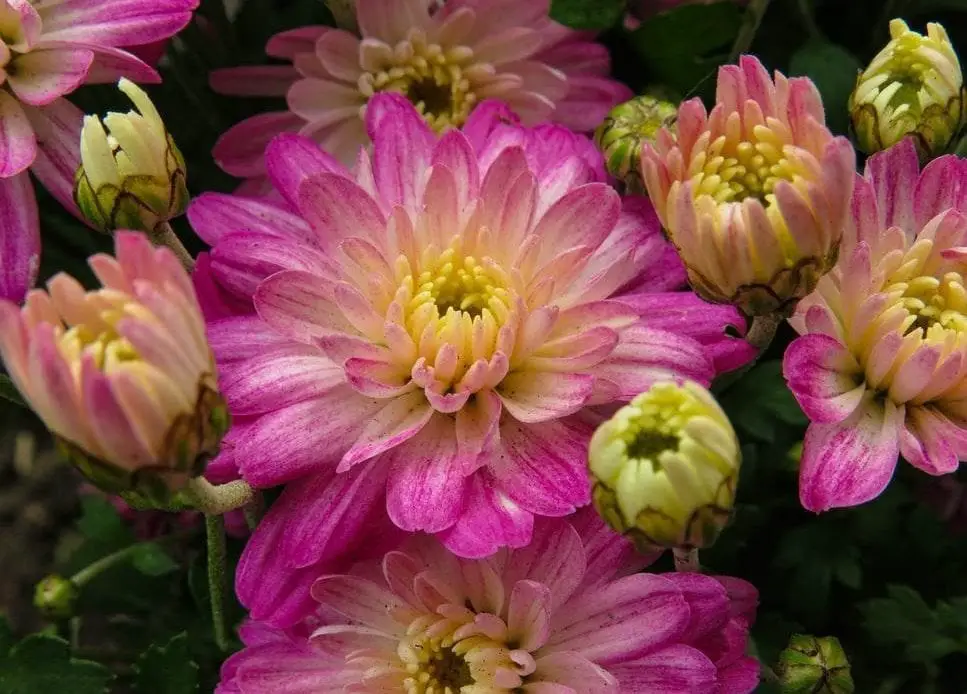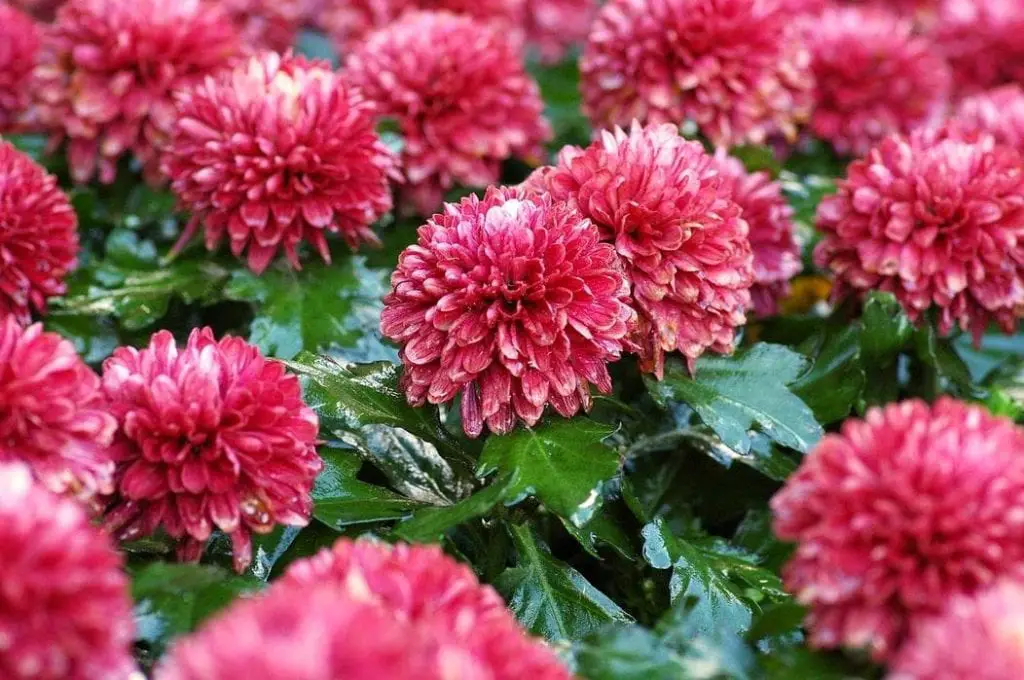
Chrysanthemums also called ‘chrysanths’ or simply ‘mums’, are an extremely popular variety of flowers grown across the globe. A chrysanthemum flower looks fairly similar to a daisy as they belong to the same family – Asteraceae.
This variety is one of the best known tropical flowering plants that blossom in all kinds of colors you can think of. You can find bountiful mums in shades of sunshine yellow, snow-white, shades of purple, pink, red, copper, and even uncommon green. The pretty flowers blooming in fall are every gardener’s delight. Some chrysanthemums bloom with a combination of more than one color, adding a brighter color palette to the garden landscape.
Depending on what time of the year they bloom, these hardy, easy to grow plants are categorized into the early blooming, middle, and late-blooming varieties. They come in annual and perennial varieties and offer gardening enthusiasts wonderful flower choices for their fall gardens. The annuals are mostly florist’s choice and bear large flowers. On the other hand, the perennials are frequently found in the sunny beds of home gardens and bloom at the right time, year after year.
Origin of chrysanthemum flower
Chrysanthemums are believed to have their origin in China. These flowers find their mention in herbal remedies and ancient pottery paintings dating back to the 15th century BC. Today, chrysanthemums are believed to be found in thousands of varieties, but not all of them fall under distinct categories. Apart from the forty-odd varieties of wild chrysanthemums, most of the garden-grown chrysanthemums have been classified to make it easier for flower growing enthusiasts.
How are chrysanthemums classified?
The chrysanthemum flower is often classified according to its shape of petals, size, blooming season, and color. Many of the varieties are unique and can be recognized at first glance. However, it is almost impossible to put all the existing varieties of chrysanthemum in place.
Here is a list of the most common chrysanthemum types –
Single chrysanthemum
Quite like the daisy, single bloom chrysanthemums are white with a light yellow center. It is among the most common varieties of the chrysanthemum flower. The petals of these mums are a little curved and are more in number compared to daisies. They have a flat center with multiple rows of equally spaced out long petals. These neatly arranged florets radiate outwards giving the flower head a neat and classy look. Being a cross between two different varieties of chrysanthemums (reflex and anemones) the single mums are distinguished by their densely packed center, bushier flowers, and moderately larger blooms. The single chrysanthemums, as their name suggests, have only one flower blooming at a time on each stem. Plants of this mum variety grow up to 3 feet (0.91 m).
Single mums also grow in smaller and semi-double varieties. Some of the common single mums are Icy Isle, Rage, Fire Island, Aurora, Tenderness, Crimson Glory, Clara Curtis, and Amber morning.
Quilled chrysanthemum
Identifying a quilled mum is easy! A look at the quill-like petals and you know to which variety of mums they belong. The florets are not only quilled but also feature an open tip that makes them so unique. The tubular petals resemble a cylindrical fold or a quilled or rolled paper and are spiny, pointy, and thin. Quilled mums can be easily spotted with their narrow tube-like petals that often have two colors. These flowers are moderately large and do not have a distinct open center like most mums. Some examples of this variety are King’s Delight, Mammoth Yellow, Lola, Muted Sunshine, Seatons Toffee, and Matchstick. The quilled variety of chrysanthemum flower comes in an array of different shades of yellows, pinks, and purples. The gaudy, quilled chrysanthemums are not too hardy and cannot tolerate freezing. They are mostly grown as annual flowering plants.
Spider chrysanthemum
The name of this chrysanthemum explains the shape of its florets that form the flower head. Their petals look like a spider’s legs- long, spiky, and thin. The florets, which are often as long as six inches spread out in all directions from the tightly packed center. Those uniquely stretched dissimilar florets give the flower a ruffled yet graceful, and lacy look. Often, the outer edges of the petals curl up to give an appearance of twisted hooks. The petals can be smooth or coarse depending on their variety. Spider mums are mostly found in shades of yellow, white, and bronze. Some common spider chrysanthemum flowers are Western Voodoo, Chesapeake, Evening Glow, Cremon, and Symphony.
Anastasia Green is an extraordinary variety of spider chrysanthemum featuring soft green florets. This variety of mums is considered rare.
Anemone chrysanthemum
Anemone chrysanthemums look quite similar to daisies and are easy to recognize with their cushioned, button-like centers. These flowers bloom in single colors or multiples hues of yellow, white, pink, and red. The small florets are arranged around the slightly bulged central disk. The tubular petals and the elevated center look like a pin-cushion. These are good as cut flowers, in bouquets, and attract pollinators like bees and butterflies. Chrysanthemum flower varieties that come under this category are Angel, Mansetta Sunset, Dorothy Mechum, Mansetta Daybreak, and Purple Light.

Pompon chrysanthemum
Depending on their size, pompons are also termed spray mums, button mums, daisy mums, and cushion mums. The compact arrangement of the petals hides the disc center completely. The systematically arranged, slightly incurved, short florets increase in size as they move outwards. That gives these small, cute chrysanthemums a globe-like appearance. Pompons grow only 1-4inches (10.16 cm) in diameter, which is smaller compared to the other varieties. Pompons bloom in a range of colors, including white, red, yellow, and lavender. The cutest and the tiniest of all are the button mums that get the name from their size. Several flowers bloom in a single stem which makes them a treat for the eyes. Moonbeam, Rocky, Pixie, Yoko Ono, Small Wonder, Lakeside, and Baby Tears are the popular varieties.
Decorative Chrysanthemum
As the name suggests, the decorative variety of mums are popular flowers in arrangements. These beautiful flowers grow on short plants and vary in size of up to 5 inches (12.7 cm). The petals of these showy blooms are methodically arranged in rows and curve slightly inward around the disc center. These prolific perennials are showstoppers in any garden.
Some popular decorative varieties are Honeyglow, Tobago, Minnruby, Fireflash, Lexy, Gold Rush, Indian Summer, Coral Charm.
Incurve Chrysanthemum Blooms
The florets in the incurve variety curve inward. Chrysanthemums that are incurved mostly have thick irregular florets and large heads up to six to eight inches. The uneven petal arrangement gives them a round, ball-like, showy, fluffy yet compact look. They flowers commonly used in corsage.
The incurve variety is further categorized into irregular incurve, intermediate and regular incurve varieties depending on their size, kind of incurve, and how their appear.
Some varieties of incurve Chrysanthemums are Goldfield, Candid, Blushing Bride, St. Tropez, Luxor, Moira, Pat Lawson, Bob Dear, Gillette, River City, Apricot, Alexis, and Heather James.
Reflex Chrysanthemums
With outward drooping florets, reflex mums have a globe-like flower. They have a flat center which is almost completely covered with feather-like florets. These are generally medium size blooms in shades of red, yellow, and orange. The flowers can attain a height of 6 inches (15.24 cm) owing to their raised and outward curved florets. White City, Burnt Copper, and Champion are some varieties of reflex mums.
Thistle Chrysanthemums
Also known as bush blooms, these mums have thin tubular florets that grow upwards and twist around the stem in an uneven droopy manner. These look like wildflowers and grow in multiple colors. The size of the flower is usually 2 inches (5.08 cm) or less in diameter. They resemble an old worn-out paintbrush. Some of these whimsical flowers like Orange Spray, Aoi, Cindy, Cisco, are used in floral sprays.
Spoon Mums
You can spot spoon mums as soon as you see them! Thanks to their long and slender spoon-like florets with a curled up open end. The well-arranged florets radiate outward from the flat disc center.
Redwing, Starlet, Fantasy, Happy Face, and Kimie are some spoon mum varieties. Shades of pinks and oranges are the most common colors for these pretty chrysanthemums.
Cushion Mums
Cushion mums are a common garden variety of chrysanthemums. They grow profusely with a burst of colors. The tightly branched, low, bushy plants bloom in abundance. These low growing plants are ideal for growing in pots, planting along pathways, or placing in front of shrubs. The flowers are medium-sized and are a favorite among ardent gardeners. They grow in all possible shades of yellow, red, pink, purple and white and combinations. Some cushion chrysanthemum varieties are Valor, Minngopher, Grandchild, Ruby Mound, Rose Grenadine, Chiffon.
Unclassified/ Exotic/ Miscellaneous
The number of mum varieties has increased over the years. Many of the uncommon blooms that belong to this family do not fit into any distinctive group. Either they are too big, have exotic florets and colors which do not match the common mums. Some such chrysanthemum flowers are Lone Star, Orange Viking, Dark Waldon, Lili Gallon, Focus, Yellow Sizzle, Pacificum, and Red Bradford.
